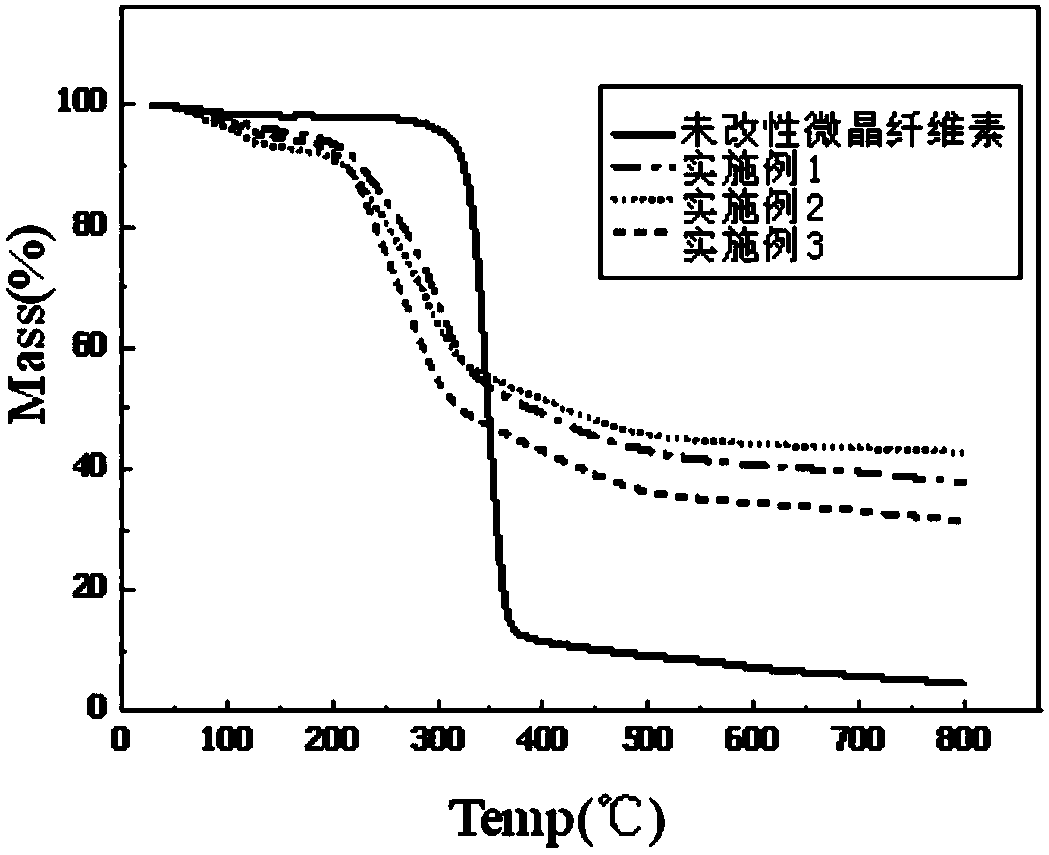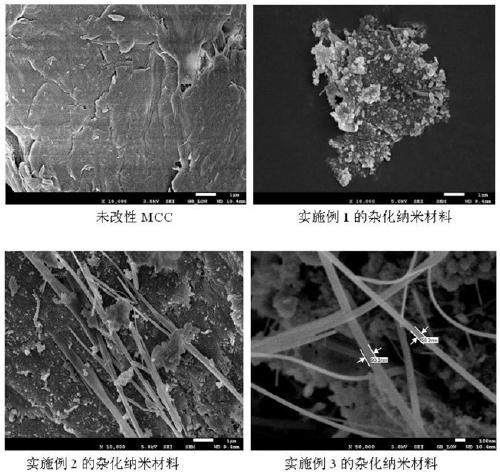Microcrystalline cellulose-nanometer silicon dioxide hybrid material, its preparation method and application
A technology of nano-silica and microcrystalline cellulose, which is applied in rolling resistance optimization, transportation and packaging, special tires, etc., can solve the problems of large MCC particle size, difficult dispersion of rubber matrix, low interaction strength, etc., to improve Reinforcing effect, effect of improving dispersibility
- Summary
- Abstract
- Description
- Claims
- Application Information
AI Technical Summary
Problems solved by technology
Method used
Image
Examples
Embodiment 1
[0031] Embodiment 1 Preparation of microcrystalline cellulose-nanometer silicon dioxide hybrid material
[0032] (1) Disperse 10 g of microcrystalline cellulose in 100 ml of ethanol, add 80 g of 4% sodium hydroxide aqueous solution, stir at high speed for 2 h and suction filter;
[0033] (2) vacuum-drying the microcrystalline cellulose obtained in step (1) for 2 hours at room temperature, so as to control the thickness range of the water film adsorbed on the surface of the microcrystalline cellulose to be 10 nm-1 μm;
[0034] (3) Disperse 5 g of swollen microcrystalline cellulose in 50 ml of ethanol and stir at high speed for 30 min;
[0035] (4) Dissolving 5g ethyl orthosilicate, 1g bis-(γ-triethoxysilylpropyl) tetrasulfide (Si69) in 100ml isopropanol;
[0036] (5) Add the microcrystalline cellulose suspension obtained in step (3) dropwise to the tetraethyl orthosilicate and Si69 solution in step (4), react in a water bath at 80°C for 0.5h, and age at room temperature for 1h...
Embodiment 2
[0037] Embodiment 2 Preparation of microcrystalline cellulose nano-silica hybrid material
[0038](1) Disperse 50 g of microcrystalline cellulose in 150 ml of ethanol solution, add 150 g of 16% sodium hydroxide aqueous solution, stir at high speed for 6 hours and suction filter;
[0039] (2) vacuum-drying the microcrystalline cellulose obtained in step (1) for 14 hours at room temperature, so as to control the thickness range of the water film adsorbed on the surface of the microcrystalline cellulose to be 10 nm-1 μm;
[0040] (3) Disperse 20 g of swollen microcrystalline cellulose in 200 ml of isopropanol solution and stir at high speed for 30 min;
[0041] (4) Dissolve 20g ethyl orthosilicate, 5g bis-(γ-triethoxysilylpropyl) tetrasulfide (Si69) in 100ml ethanol;
[0042] (5) Add the microcrystalline cellulose suspension obtained in step (3) dropwise to the tetraethyl orthosilicate and Si69 solution in step (4), react in a water bath at 80°C for 3h, and age at room temperatu...
Embodiment 3
[0043] Embodiment 3 Preparation of microcrystalline cellulose-nanometer silicon dioxide hybrid material
[0044] (1) Disperse 30 g of microcrystalline cellulose in 100 ml of ethanol, add 115 g of 10% sodium hydroxide aqueous solution, stir at high speed for 4 h and suction filter;
[0045] (2) vacuum-drying the microcrystalline cellulose obtained in step (1) for 20 h at room temperature, so as to control the thickness range of the water film adsorbed on the surface of the microcrystalline cellulose to be 10 nm-1 μm;
[0046] (3) Disperse 12.5 g of swollen microcrystalline cellulose in 125 ml of ethanol and stir at high speed for 45 min;
[0047] (4) Dissolve 12.5g ethyl orthosilicate, 3g bis-(γ-triethoxysilylpropyl) tetrasulfide (Si69) in 100ml ethanol;
[0048] (5) Add the microcrystalline cellulose suspension obtained in step (3) dropwise to the tetraethyl orthosilicate and Si69 solution in step (4), react in a water bath at 80°C for 2h, and age at room temperature for 6h, ...
PUM
| Property | Measurement | Unit |
|---|---|---|
| thickness | aaaaa | aaaaa |
| particle diameter | aaaaa | aaaaa |
| diameter | aaaaa | aaaaa |
Abstract
Description
Claims
Application Information
 Login to View More
Login to View More - R&D
- Intellectual Property
- Life Sciences
- Materials
- Tech Scout
- Unparalleled Data Quality
- Higher Quality Content
- 60% Fewer Hallucinations
Browse by: Latest US Patents, China's latest patents, Technical Efficacy Thesaurus, Application Domain, Technology Topic, Popular Technical Reports.
© 2025 PatSnap. All rights reserved.Legal|Privacy policy|Modern Slavery Act Transparency Statement|Sitemap|About US| Contact US: help@patsnap.com



